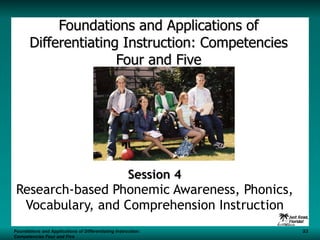Session 4
•Als PPT, PDF herunterladen•
1 gefällt mir•712 views
Melden
Teilen
Melden
Teilen

Empfohlen
Weitere ähnliche Inhalte
Was ist angesagt?
Was ist angesagt? (20)
Ähnlich wie Session 4
Ähnlich wie Session 4 (20)
E10 01 techniques and principles in language teachingt cap 2

E10 01 techniques and principles in language teachingt cap 2
Oral Language Assessment In The Classroom 20080415

Oral Language Assessment In The Classroom 20080415
EFFECTIVE FLUENCY STRATEGIESStudent NameUniversity NameDat.docx

EFFECTIVE FLUENCY STRATEGIESStudent NameUniversity NameDat.docx
Mehr von Miami-Dade County Public Schools
Mehr von Miami-Dade County Public Schools (20)
M-DCPS Teacher LEADership Academy: A Human Capital Investment

M-DCPS Teacher LEADership Academy: A Human Capital Investment
Building Educator Success through Teamwork PLSTs Fall 2016

Building Educator Success through Teamwork PLSTs Fall 2016
Session 4
- 1. Foundations and Applications of Differentiating Instruction: Competencies Four and Five Session 4 Research-based Phonemic Awareness, Phonics, Vocabulary, and Comprehension Instruction Foundations and Applications of Differentiating Instruction: S3 Competencies Four and Five
- 5. Foundations and Applications of Differentiating Instruction: Competencies Four and Five S3 -
- 7. Fluency Group Presentation Foundations and Applications of Differentiating Instruction: Competencies Four and Five S3 -
- 8. Phonics Presentation Foundations and Applications of Differentiating Instruction: Competencies Four and Five S3 -
- 9. Phonemic Awareness Presentation Foundations and Applications of Differentiating Instruction: Competencies Four and Five S3 -
- 10. Vocabulary Presentation Foundations and Applications of Differentiating Instruction: Competencies Four and Five S3 -
- 11. Comprehension Presentation Foundations and Applications of Differentiating Instruction: Competencies Four and Five S3 -
- 12. Oral Language Foundations and Applications of Differentiating Instruction: Competencies Four and Five S3 -
Hinweis der Redaktion
- Use the sentences about phonemic awareness, phonics, fluency, vocabulary, and comprehension provided below to prepare a review activity. Prior to the session, choose one sentence from each component. Write each word of the sentence on separate sticky notes. Place one “sentence” at each table (scramble the words). Divide participants into five groups. Direct participants to choose a table and unscramble the sentence. After 3-5 minutes, ask participants to record their sentence, rescramble the words, and rotate to the next table. Participants will repeat this process until they have completed all five components. After the activity is completed, allow time for the participants to compare and discuss the sentences.
- Unscramble sentences.
- Serve as guideline for evaluating programs
- Participants will be given from 1 to 6 cents as they enter the room. Participants will be grouped by the number of pennies that they have. Mingle, approach each other, and let each other know how many pennies they have. Organize into groups having the same number of pennies. Introduce themselves and tell a number of things about themselves that corresponds to the number of pennies they have. Each group will be given a pre-selected term related to reading. Groups are to discuss this topic and then share with the whole group. 1 penny: Phonics 2 pennies: Fluency 3 pennies: Phonemic Awareness 4 pennies: Vocabulary 5 pennies: Comprehension 6 pennies: Oral Language
- As the participants read the papers, they need to be thinking about how to present the information to the rest of the participants. They should be prepared to address the following in their presentation (Slide S3-3): • Provide the component definition. • Describe instructional practices which would be appropriate for a low progress, an average progress, and a high progress reader and be prepared to share their rationale. • Are you differentiating for content, process, or product with each of the chosen instructional practices? Explain. Encourage each group to involve the remaining participants while presenting their information. Allow participants about 30 minutes to work in their groups to prepare for their presentations. Each group will have about 30 minutes to present. Complete Instructional Practices in the Reading Classroom.
